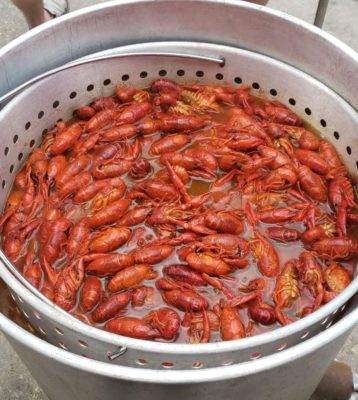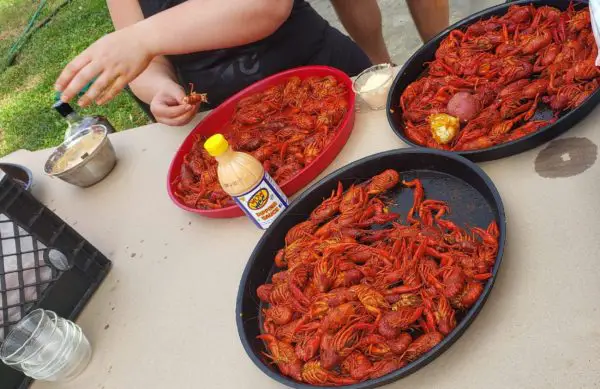Crayfish. Crawdads. Mudbugs.
In Louisiana, you won’t hear those terms – people will quickly tell you these delicious little crustaceans are called crawfish. They look like miniature lobsters and are usually served boiled or fried but are also featured in numerous other recipes.
We’re going to give you a little history about how crawfish became one of Louisiana’s favorite types of seafood and share with you a local favorite recipe of crawfish etouffee. Keep reading to learn a little about the food culture in Louisiana and how to make a dish that will wow your friends and family.

How Crawfish Gained Their Popularity
Although Louisiana lore states that the Acadians (first settlers in Louisiana outside of Native Americans) are credited with bringing lobsters with them from Nova Scotia and the Northeastern parts of the US, this is obviously false.
Actually, Native Americans were the first to eat this type of shellfish, by catching it with reeds baited with deer meat. Once the Acadians relocated to Louisiana bayous, they realized that crawfish were abundant and relatively easy to catch.
In the 1800s, the commercial selling of crawfish gained popularity due to people using nets (instead of reeds or string) to harvest larger crops. For a long time, people considered crawfish to be a ‘poor man’s dish’ until about 1960 when restaurants began including crawfish dishes on their menu.
In 1983, Louisiana was the first state to name an official ‘state crustacean,’ showing that the crawfish’s importance to the culture was solidified.
A Way of Life

The months of February until June mark ‘crawfish season.’ Generally, the beginning of this season comes with the start of Mardi Gras and lent. If you’re unfamiliar, lent is a period of fasting or abstinence for the 40 days before Easter. It is meant to be a spiritual time for people of various religions to reflect, be grateful, and grow spiritually.
As 26% of Louisiana’s population is Catholic, you can guess that lent is taken seriously. Because of this, on Fridays, many people choose not to eat beef, pork, or chicken; shellfish and fish are exempt from this rule as they are not considered meat.
Even for the non-religious, shellfish (especially crawfish) is a way of life. Many people choose to have crawfish boils. These boils are a reason for families and friends to come together, cook, eat, drink, and socialize.
Sausage, corn, red potatoes, mushrooms, garlic, and onions are also served, boiled in the same water as the crawfish, creating a feast for all attendees. Quite often, the mix of crawfish and ‘fixings’ are placed on a communal table or in crawfish trays (seen above) for everyone to enjoy.
On the other side of this, crawfish farming is a way for many Louisianians to make money. For most of these farmers, this vocation is generations old and the land has been handed down. As crawfish continues to gain popularity, many of the smaller farming operations grow and become fully commercialized, offering live, boiled, or peeled and packaged crawfish.
As mentioned, crawfish season runs from February to June but that doesn’t mean the flow of this crustacean ever truly stops. The packaged crawfish that you can buy from a Louisiana crawfish company can be frozen and used at a later date.
If you ask most Cajuns, they’ll tell you that it’s never too hot for gumbo or a dish of etouffee!
Crawfish Etouffee

The options are endless when it comes to what recipes you can use crawfish for. One of the local favorites, however, is crawfish etouffee.
To create this dish, you will need the following:
- 6 tbsp butter
- 6 minced cloves of garlic
- 7-8 c. chicken broth
- 2 bay leaves
- 2-3 sprigs of thyme (dried will work too)
- 1 c. diced, peeled, and seeded tomatoes
- 1.5 tsp salt
- 2 tsp Worcestershire sauce
- 2 lbs peeled crawfish tails (with fat)
- 1 tbsp lemon juice
- 1 c. chopped green onions
- 4 tbsp flour
- 2 c. chopped onion
- ½ c. chopped celery
- ½ c. chopped bell pepper
- Red pepper flakes to taste
- Hot sauce to taste
- Rice (your preference) for serving
To begin this dish, you will cook a roux (pronounced roo) by melting 4 tablespoons of butter and whisking the flour into it. This is one of the most important steps and if you can master it, you can cook almost every Cajun dish.
Constantly stir your roux while it browns – your goal is a caramel or peanut butter color.
Next, add your onion, celery, and bell pepper; this group of vegetables is known as the “Trinity” in Louisiana cooking; they go in almost everything! Also, add the garlic, bay leaves, and thyme; cook this combination for about 7-9 minutes; or until the vegetables are soft. You can usually tell they’re done because the onion will become almost translucent.
Once your vegetables are cooked and your kitchen is smelling delicious, add 6 cups of the chicken stock, the tomatoes, red pepper, salt, Worcestershire sauce, and hot sauce to taste. Bring your creation to a boil. Once this is boiling, skim the surface to remove the grease that comes to the top.
Leave your pot uncovered, reduce heat to a simmer, and cook for 30 minutes. Be sure to stir the pot to keep your dish from burning.
Finally, you will add the 2 pounds of crawfish tails, parsley, lemon juice, and green onions. Cook this for about 15-20 minutes; if the mixture begins to get too thick, you can add a bit of your reserved chicken stock – the goal is to create a thick soup-like consistency.
Add your last two tablespoons of butter and add any extra seasoning you may want.
Serve the etouffee hot over rice and enjoy!
No Imitations, Please!
Due to the seafood demand in Louisiana, the state has recently passed a law to ensure that all restaurants and stores tell patrons whether their seafood is sourced locally or imported from another country.
This is to ensure that restaurants stay honest and the people receive the product they believe they’re paying for: locally harvested crawfish, shrimp, and crab.
No one does shellfish quite like Louisiana – and the new law helps everyone stay honest, support local businesses, and continue eating the best seafood around.
Next time you’re in the market for crawfish, be sure to look for the label stating that they were farmed in Louisiana to get the best possible product!


